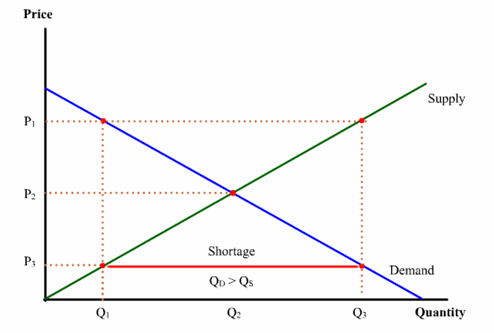Rent Ceiling
Rent control in Boston, MA has led to most apartments charging rent right up to the price ceiling. The effective rent is actually higher if under-the-table payments are included.
I spent my freshman year of college at Boston University. I lived in one of the dormitories the first semester. However, for the second semester two of my friends and I decided to live in an apartment.
We began searching for an apartment near the campus and discovered many realities of apartment hunting. The first realtor we asked told us that an apartment with three rooms and two baths would cost $1700 per month. The second realtor and the third realtor also told us the same price. Moreover, all the apartment complexes had waiting lists. Some even turned us down immediately. We were curious as to why the price was exactly the same for some places and why it was so difficult to find a place to live. Was there no 3-bedroom apartment available for $1500 or maybe even $1600?
When we told our story to one of our professors, he informed us of a rent ceiling that had been imposed a few years earlier. The city of Boston has set a limit on how much an owner could charge for different types of apartments. For a 3-bedroom apartment the limit was then $1700. We then understood why everyone was charging the maximum price they possibly could.
However, we didn’t understand why some places that had advertised turned us down immediately. Our professor once again told us the secret. He said that if we offered to pay $100 to $150 extra for rent, we could get an apartment without many hassles. The only catch was that the extra rent would be paid separately as cash so that no one would find out. We could hardly afford $1700 much less $1800. As a result, we ended up living in the dormitories once again!
What we encountered was a case of price ceilings at work. Since rent was so high in some areas in Boston, the city decided to place a rent ceiling in order to help people, like us, who could not afford expensive apartments. But the ceiling created a problem for the owners. They were not receiving as high a rent as they would have liked to receive. Since the rent became controlled, many people could pay for apartments, which created a shortage. The ceiling caused quantity demanded to exceed quantity supplied. There were only a limited number of apartments in the area, but the number of possible residents increased once the price fell.
The under-the-table payment (in the so-called black market) was one way to raise the effective price to the market-clearing (i.e., equilibrium) level. But because the effective price was higher than the rent ceiling, renters with limited budget like college students were not helped at all.
Notes:
- A. Pareek is an undergraduate Business Administration major at Drury University.
- Editor's note: Rent control inevitably leads to depletion of rental housing stock because of inadequate maintenance, barrier to higher-density rental housing development, and conversion from rental to non-rental housing.
Glossary:
- price ceilingWhen prices are set artificially below the market-clearing level, the controlled price is a ceiling above which it is not allowed to rise. A price ceiling would result in excess demand or shortage.

- shortageThe excess of quantity demanded over quantity supplied at a given price. Also known as excess demand.

Topics:
Keywords
apartments, black market, Boston, equilibrium price, price ceiling, rent ceiling, rent control, shortage, under-the-table payment
